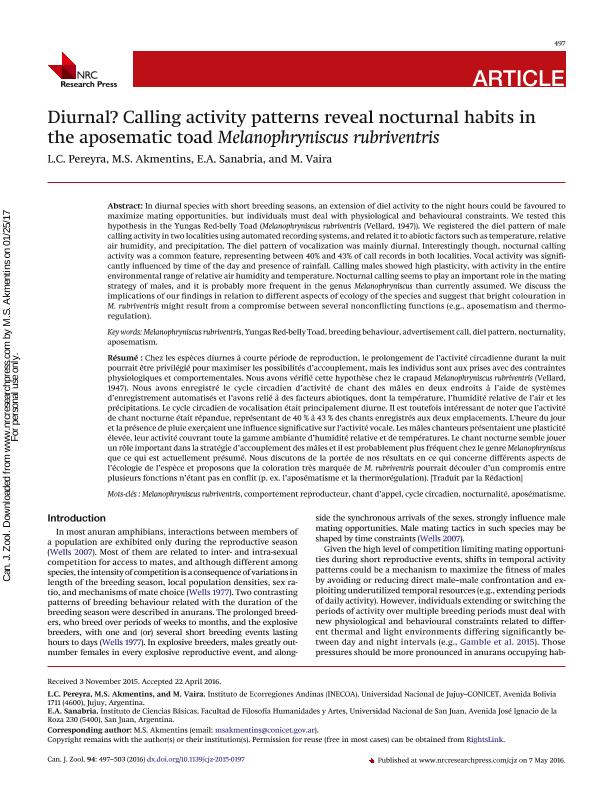Artículo
Diurnal? Calling activity patterns reveal nocturnal habits in the aposematic toad, Melanophryniscus rubriventris
Fecha de publicación:
07/2016
Editorial:
National Research Council Canada-NRC Research Press
Revista:
Canadian Journal of Zoology
ISSN:
0008-4301
Idioma:
Inglés
Tipo de recurso:
Artículo publicado
Clasificación temática:
Resumen
Abstract: In anuran species with short breeding seasons, an extension of diel activity to the night hours could be favoured to maximize mating opportunities but individuals must deal with physiological and behavioural constraints. We tested this hypothesis in the Yungas red-belly toad, Melanophryniscus rubriventris (Vellard, 1947). We registered diel pattern of male callingactivity in two localities using automated recording systems, and related it to abiotic factors as temperature, relative air humidity and precipitation. The diel pattern of vocalization was mainly diurnal. Interestingly, though, nocturnal calling activity was a common feature, representingbetween 40% and 43% of call records in both localities. Vocal activity was significantly influenced by time of the day and presence of rainfall. Calling males showed high plasticity, with activity in the entire environmental range of relative air humidity and temperature. Nocturnal calling seems to play an important role in the mating strategy of males, and it is probably morefrequent in the genus Melanophryniscus than currently assumed. We discuss the implications of our findings in relation to different aspects of ecology of the species and suggest that bright coloration in M. rubriventris might result from a compromise between several non-conflicting functions (e.g. aposematism and thermoregulation).
Archivos asociados
Licencia
Identificadores
Colecciones
Articulos(CCT - SAN JUAN)
Articulos de CENTRO CIENTIFICO TECNOLOGICO CONICET - SAN JUAN
Articulos de CENTRO CIENTIFICO TECNOLOGICO CONICET - SAN JUAN
Articulos(SEDE CENTRAL)
Articulos de SEDE CENTRAL
Articulos de SEDE CENTRAL
Citación
Pereyra, Laura Cecilia; Akmentins, Mauricio Sebastián; Sanabria, Eduardo Alfredo; Vaira, Marcos; Diurnal? Calling activity patterns reveal nocturnal habits in the aposematic toad, Melanophryniscus rubriventris; National Research Council Canada-NRC Research Press; Canadian Journal of Zoology; 94; 7; 7-2016; 497-503
Compartir
Altmétricas




